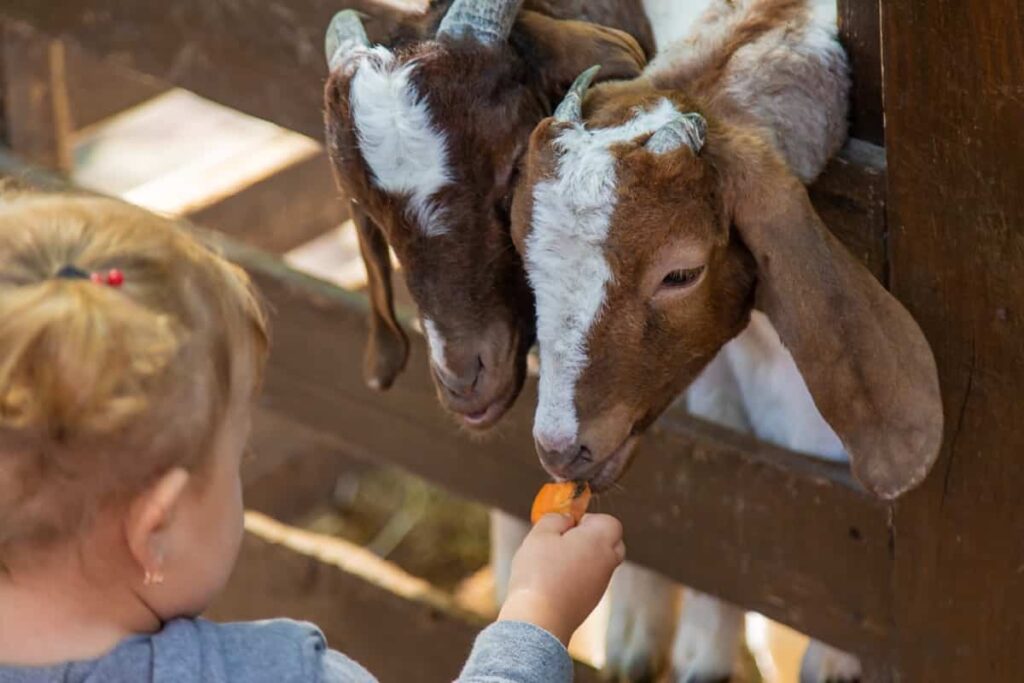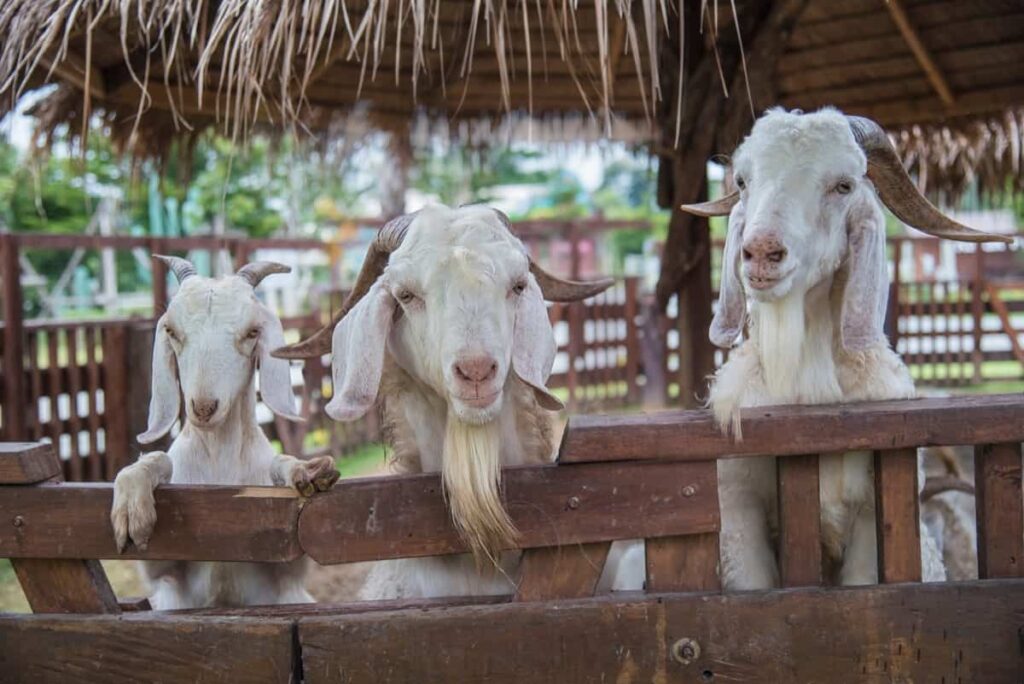We will look into eco-friendly goat farming techniques that are profitable and sustainable for the environment. Many impoverished villagers rely on goat production as their primary source of income, as goats provide a variety of products, including milk, flesh, fiber, and skin. However, traditional goat husbandry practices can have detrimental environmental effects.

Farmers can reduce this impact by implementing eco-friendly practices while improving animal health and productivity. We will discuss several sustainable practices, including organic feed, rotational grazing, and appropriate sanitation and hygiene.
Sustainable Goat Farming Practices
What are Sustainable Goat Farming Practices
Sustainable goat farming practices promote ways of raising goats that are good for the environment and make money. Many poor people make a lot of money from goats because they can be used to make milk, meat, fiber, skin, and other things. Commercial goat farming, which uses intensive and semi-intensive methods for production, has become a key factor in India’s agricultural growth and has the potential to make a big difference in rural development.
Commercial goat farming means raising goats using better management techniques to get the most money from the business. In the semi-intensive method, goats only have limited access to free-range grazing. They are kept in stalls and fed tree leaves, dry fodder, and a mixture of concentrates. In the intensive system, goats are always kept in stalls and have limited access to land (zero-grazing system). They are fed farmed fodders, crop residues, concentrates, or feeds that have been mixed.
The Scenario of Goat Farming
Goat farming is an important sector of the livestock industry, and Asia and Africa are the leading contributors to the world’s total goat population. Africa accounts for 53% of the world’s goat population, while India, China, Pakistan, and Bangladesh have the highest shares of the population in Asia. In India, goat farming is an ancient practice, still prevalent today. The country has the highest goat milk production and the world’s second-highest sheep and goat meat production.
Rajasthan has the highest goat population in India, followed by West Bengal, Uttar Pradesh, Bihar, and Madhya Pradesh. Farmers in India hold an average of 5 to 20 goats in their small land, making it a profitable business. Goat farming is also a sustainable practice, especially during drought conditions, and requires less maintenance than cows and other livestock.
In case you missed it: Building a Cheap Goat Shed – A Beginners Guide

Benefits of Goat Farming
- Goats are an excellent source of protein and provide low-fat, low-cholesterol, high-vitamin, and high-mineral meat and milk.
- Goat products have become sought-after commodities in developed countries, and the goat cheese industry has become a major niche market in Europe and the United States.
- In rural areas of developing countries, goats contribute significantly to feeding resource-poor populations.
- Goats can be raised in small landholdings and are ideal for household milk and meat production.
- Goat farming provides a source of income and nutrition for smallholder farmers.
Importance of Sustainable Goat Farming Practices
- Sustainable goat farming practices promote economic, environmental, and social sustainability.
- Sustainable practices include proper goat nutrition, breeding and health management, and using natural resources.
- Sustainable goat farming practices also promote biodiversity and protect natural resources.
- Sustainable goat farming practices are critical for ensuring the long-term viability of the goat farming industry.
- Sustainable goat farming practices help reduce poverty and promote food security while promoting a healthy and sustainable environment.
Importance of Eco-Friendly Goat-Raising Methods
- Eco-friendly goat-raising methods are essential for sustainable livelihoods for small farmers.
- Providing a boost to the income of small farmers by over 100%.
- Reduced mortality of goats and improved growth rate.
- Increased weight of newborn kids and a higher price realization due to better marketing negotiations.
- Goats raised through eco-friendly methods require fewer expenses on service charges, deworming, vaccinations, and treatment.
- Eco-friendly goat-raising methods can help protect the environment.
- Farmers must be educated and trained on feeding and fodder production, improving goat breeds, maintaining goat health, and effective marketing techniques to achieve eco-friendly goat-raising practices.
- Providing critical inputs, technical advice, field demonstrations, and village-wise camps can help achieve this goal. Further, micro-credit through SHGs can help prevent distressed sales of goats, and direct selling to butchers or large urban markets can fetch higher prices.
Breeds that are Suitable for Eco-Friendly Farming
- Goats are an ideal choice for eco-friendly farming. For milk production, milch breeds such as Jamunapari and Surti are ideal, while locally available meat breeds like Barbari and Kutchi are recommended for meat production.
- Some popular breeds include the Salem Black, well-adapted to harsh climatic conditions, and the Osmanabadi, known for its early maturity and prolificacy.
- Other breeds like the Gohilwadi and Zalawadi are adapted to hot semi-arid climates and have unique physical features like slightly twisted horns and long droopy ears.
In case you missed it: Effective and Profitable Commercial Goat Farming: Key Rules to Start from Scratch, Best Milk and Meat Goat Breeds

Eco-friendly Goat Raising Methods
- Eco-friendly goat-raising methods focus on minimizing the impact of goat farming on the environment while maximizing animal welfare and productivity.
- Grazing management: Rotational grazing helps maintain pasture health and reduces soil erosion. Goats can also help control invasive plant species.
- Feed: Locally sourced, organic feed reduces the carbon footprint of goat farming.
- Shelter: Housing should be well-ventilated and protected from extreme weather conditions.
- Waste management: Composting manure can reduce greenhouse gas emissions and provide a natural fertilizer for crops.
- Health management: Regular preventative care, such as vaccinations and parasite control, can reduce the need for antibiotics and other medications.
Case Study of Eco-friendly Goat Raising Methods In India
Goat keeping is an important source of livelihood for resource-poor people, but their indiscriminate feeding habits can threaten the ecology. BAIF has initiated sustainable goat-rearing programs in various states, such as Gujarat, Rajasthan, Karnataka, and West Bengal, to address this. The program covered 135 villages in West Bengal with 10,000 goat-keeping families in Burdwan and Bankura districts.
Field guides were selected from the same villages to motivate goat keepers to adopt best practices, and goat keepers were organized into groups and trained on best goat husbandry practices. Black Bengal, a breed known for its superior quality meat and skin, was improved by providing elite bucks for breeding service to does own by the members.
Goat-keeping families can earn a net annual income of Rs. 7000 to Rs. 8000 annually by selling eight surviving goats after deducting expenses on service charges, deworming, vaccination, and treatment. The goat keepers were trained on vaccination and deworming practices to maintain the goats’ health. Field demonstrations were organized on feeding concentrates, mineral mixtures, and green fodder for selected goat keepers.
In case you missed it: Best Meat and Milk Goat Breeds in India: Considering these Goats in Commercial Goat Farming Business

Conclusion
Adopting sustainable goat husbandry practices through eco-friendly goat-raising techniques benefits not only the environment but also the health and productivity of the goats. By concentrating on grazing management, feed, shelter, waste management, and health management, producers can create a profitable and environmentally friendly farming operation.
- Types of Grass Growing for Goat Farm
- How to Train Goats for Milking: A Beginners Guide
- Goat Milking Practices and Equipment: A Beginner’s Guide
- Goat Farming for Fiber: Producing Mohair and Cashmere
- Maximizing Goat Milk Production: Tips for Dairy Goat Farmers
- Goat Farming as a Family Business: Strategies for Success
- Profitable Kenya Goat Breeds for Commercial Dairy and Meat Business
- Unlock the Secrets of Oberhasli Goat: Discover Raising and Management Practices
- Ultimate Guide to Myotonic Goats: Explore Profile to Raising